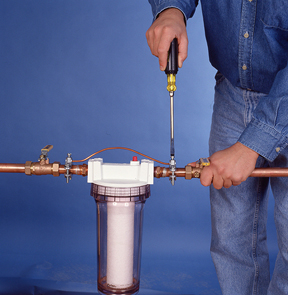by Merle Henkenius
If your home’s drinking water has an unpleasant taste or is occasionally cloudy, an inline water filter is often an easy and inexpensive fix. Private water wells can deliver off-tasting water and waterborne sediment. Accumulating sediment can short-out electric water heaters and reduce the efficiency of gas water heaters.
Although sediment is less of a problem in municipal systems, city water can have an off taste as well. Every town with a population above 100 must meet strict federal water-safety standards, and sometimes the methods used to sanitize municipal water will give it an unpleasant taste.
Inline filters, used singly or in tandem, can improve both problems and can also be used under sinks for single-fixture protection. The good news is that inline filters are affordable, ranging between $25 and $100. Expect to pay more for larger pipe diameters and for built-in shut-off mechanisms, which make changing media cartridges quick and easy. Filter cartridges need to be replaced every couple of months, especially charcoal filters, which can dump impurities in high concentrations when fully saturated.
Here’s a quick guide to installing your own inline filter.
Step 1: Attach the Filter
When installing a basic whole-house filter, you’ll need to cut out a section of water supply line and splice the new filter between two shut-off valves. If possible, isolate your home’s outside faucets since your lawn and garden won’t need filtered water. This will help your filters last longer. The simplest approach is to solder male adapters to two short pieces of copper pipe, then wrap the male threads with Teflon tape and tighten the adapters into the plastic filter head.
Step 2: Tighten the Compression Fittings
Soldering pipes that retain even a little water can be a struggle, so I suggest completing the installation with ball valves fitted with compression fittings. Assemble the filter body and the shut-off valves and tighten the compression nuts until they feel snug. However, be careful not to overtighten to avoid crushing the compression rings. Generally, when you feel first resistance with a wrench, tighten each nut one full turn and walk away.
Step 3: Restore Conductivity
You could also choose to use plastic PEX pipe and fittings to make your connections. PEX is now code-approved and doesn’t require soldering. But if your piping system is made of copper, brass or steel, plastic can create a significant potential hazard. There’s a good chance the electrician who wired your home used that water piping, which continues underground to the street to ground your home’s electrical service panel- at least in part. In fact, even our plastic filter housing would sever that connection. To restore conductivity, install a code-approved grounding clamp on each side of the filter and jump the plastic with a short piece of #6 ground wire.
Of course, if at any point you feel yourself getting in over your head, call a licensed plumber.
A Primer on Private Water Well Purity
As a rule, deep wells produce the cleanest water while shallow wells produce the best-tasting water. Deep wells are clean because surface water, its source, has to filter through hundreds of feet of permeable rock, sand and gravel to reach its aquafer depth. Contaminants are simply left behind in the grit, but in the process, the water absorbs some of the rock’s soluble minerals, and minerals in high saturation tastes bad.
Water from a shallow well, on the other hand, won’t have percolated through much rock. It won’t have a mineral taste, but it may also retain some of its contaminants.
Local health departments require that all new, private-water wells be tested for contaminants, typically coliform bacteria, nitrates and a few heavy metals. The same goes for older wells put back into service. If your well fails any part of this test, contact a water-treatment specialist.
About the author: Merle Henkenius is a longtime writer and photographer who specializes in home improvement articles and books. He is a licensed master plumber but has hands-on experience in nearly every phase of construction. He has contributed scores of articles and thousands of photos to national magazines. He also writes for The Home Depot, where you will find a large selection of water filtration systems like the one described in this article.






